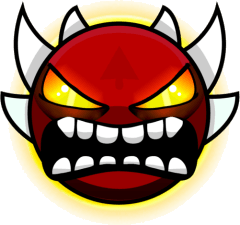Review of Thinking Space II
byEven as someone who doesn't like OG Thinking Space that much, the main value of the original lies in how stop-start the level's structure is. It's bouncing between many different ideas both in terms of the gameplay and decoration department. You see this in a lot of other levels of this vein- think Bass Cave or Fexty or Lightwave or kowareta, where you're placing unique setpieces one after another to convey conflict between the level and the player. You can think of Thinking Space as an adversary who is trying to throw an entire arsenal at you to slow your movement down, and Hideki makes use of very clear, minimal decoration and contrasting visuals to sell that even more. It makes sections such as that first, fast memory cube, or the wave with the moving pillars, much more staying power, as if it's a named attack from a video game boss. Hideki doesn't execute this remarkably well all the time but it works in a few parts and that's where the value lies in the original.
I cannot say the same for Thinking Space II. This level brings homogeneity in droves, and it results in each setpiece not standing out in any particular way, a direct contrast from the first. This is largely due to the decoration- the heightened detail of each part makes the experience a wash overall, since you can't pick out differences the same way you can for the first one, and it also obscures anything that might be interesting going on with the gameplay. Furthermore, they employ a lot of representational art here which I think doesn't really fit the mold of OG thinking space- not only is it a contrast issue, but it's also defining the space of a level that I don't think needs it. Think about the title, Thinking Space- it's a space devoted to abstract thought, spontaneous in nature, not taking any definitive form until observed, which helps the viewer fill in the gaps in their own mind. The original is the very definition of "stream of consciousness" yet strictly defining structures and objects in the sequel feels incredibly wrong here- it's a gross misunderstanding of the originals attempted genius.
Expanding on gameplay, unlike the first level, which did bring a few interesting ideas to the table (to mixed results), this level doesn't really do that as well. The way that the icon traverses through this level is quite standard and doesn't reach the same highs that OG Thinking Space does as a result. I would say the closest it gets to matching the original is NcaT's part which has one decent idea, but one interesting structure movement does not a good level make. The rest of the gameplay is a wash as well- nothing interesting or standout is being done here!
I think that if more perceptive creators were brought on this could've been a salvageable level- creators who have a good eye for understanding what makes levels tick and where their value lies. To me, this level reads as nothing more than a level along the lines of Dark Dimension, or Firework, or Descent Into Exile, or Calculator Core- just another worthless extreme demon that's in grayscale. It hurts a lot more here though because you have a really good concept to work off of and you've blown that opportunity. A real shame.
GDPR Cookie Consent
Hyperbolus uses cookies and local browser storage to enable basic functionality of the site. If we make any changes to these options we will ask for your consent again.
sorry about this gang
